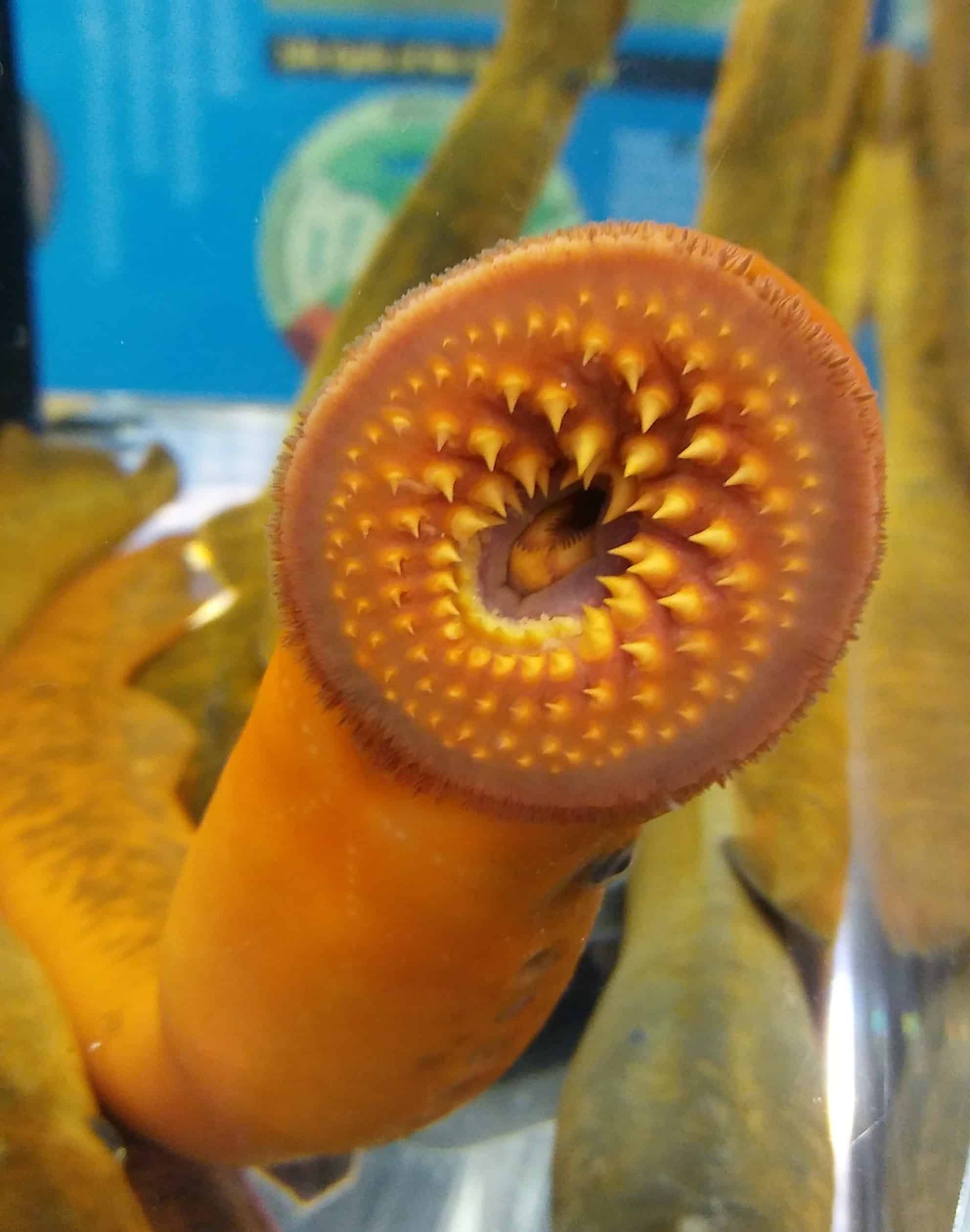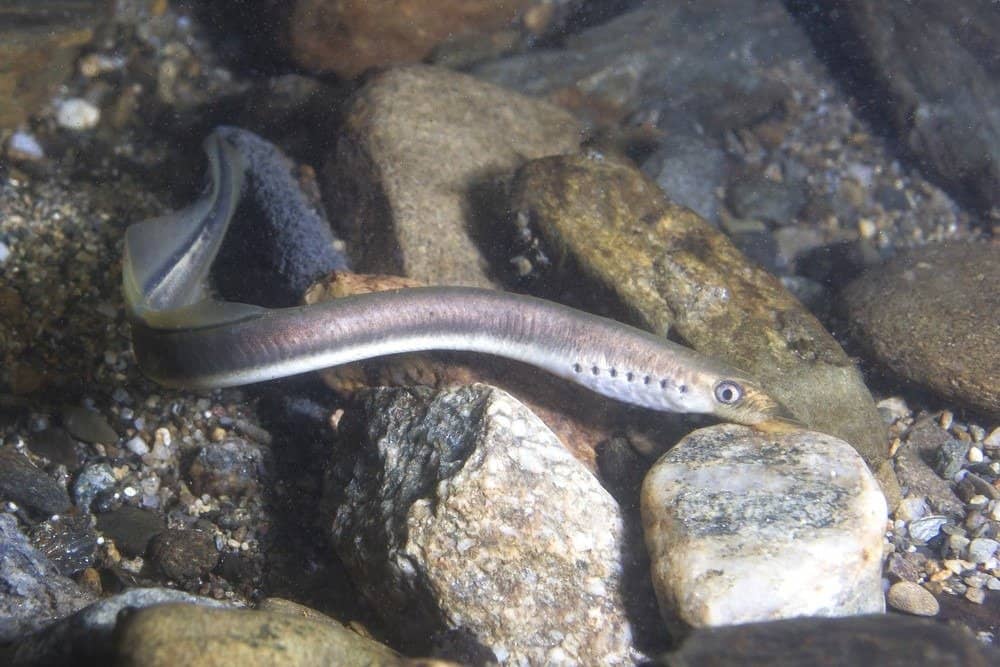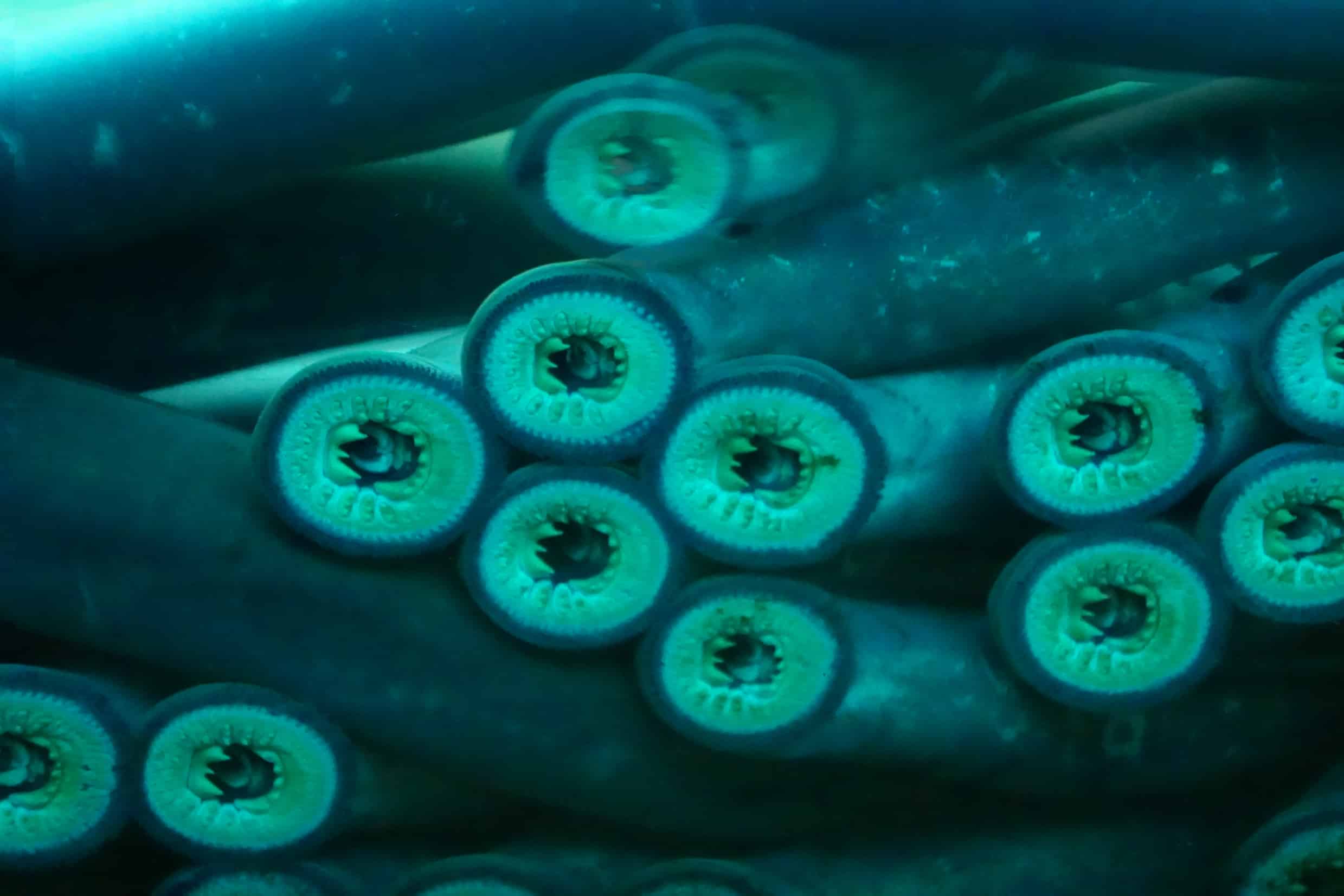Lamprey teeth are not your average set of pearly whites. These eel-like creatures, with their razor-sharp teeth arranged in a circular mouth, have been terrorizing fishermen for 360 million years. But beyond their fearsome reputation, lamprey teeth hold a unique and fascinating place in the world of biology. Lamprey teeth are providing insights and inspiring new materials for human technology. So, let’s sink our teeth into the topic and explore the fascinating world of lamprey teeth!

Lampreys do not have teeth in the same way that many other animals do. Instead, they have a circular, sucker-like oral disc with small, sharp projections. These help them attach to and scrape against the skin of their prey.
©Theresa Grace/Shutterstock.com
What Kind of Teeth Do Lampreys Have?
Despite looking like, being thought of, and referred to as eels, lampreys aren’t eels. Lampreys are jawless, aquatic animals that belong to the class Agnatha. There are approximately 40 recognized species of lampreys, 10 of which are native to North America. These species are found in both freshwater and marine environments and are widely distributed across the continent. They are recognized by their unique oral disc, which is a circular sucker-like structure containing rows of teeth.
Lampreys do not have teeth in the same way that many other animals do. Instead, they have a circular, sucker-like oral disc with small, sharp projections. These help them attach to and scrape against the skin of their prey. The small, sharp projections around the circular mouth of a lamprey are made of hypermineralized keratin. These are similar to human hair and nails, as well as the claws, hooves, and horns of many other animals. The keratinized projections in the lamprey’s mouth are used to help the lamprey attach to its prey and scrape away the skin.

Despite looking like, being thought of, and referred to as eels, lampreys aren’t eels. Lampreys are jawless, aquatic animals that belong to the class
Agnatha, like this European brook lamprey (
Lampetra planeri).
©Rostislav Stefanek/Shutterstock.com
Lamprey Larval Teeth
The dentition of lamprey larvae is adapted for filter feeding. Lamprey larvae, also known as ammocetes, hatch from eggs. They begin life with a small, round mouth that contains small teeth-like projections called hood teeth. These teeth are used for filter-feeding on small particles in the water, such as algae and plankton. As the larval lamprey metamorphoses into an adult, its hood teeth are gradually replaced by the adult oral disk. Depending on the species, lampreys may spend most of their lives as larvae. This is also the case for the Northern brook lamprey (Ichthyomyzon fossor).
Lamprey Adult Teeth
Lampreys do not have true teeth in the sense that other vertebrates do. However, they have tooth-like structures arranged in circular rows within their oral disc. There are several rows of these structures in the lamprey’s mouth, which are named according to their location and function:
- buccal papillae
- inner lateral teeth
- outer lateral teeth/marginal teeth
- pharyngeal teeth
- esophageal teeth
Buccal Papillae
Buccal papillae are located on the extreme outer edge of the oral disk. These structures help the lamprey detect prey and other objects in the water. Some species of lamprey use their buccal papillae to attach to the skin of other fish while feeding. The papillae also help regulate water flow in and out of the lamprey’s mouth during feeding.
Inner Lateral Teeth
The inner lateral teeth are specialized structures made of a tough, keratin-like material, arranged in circular rows. The arrangement and shape of the inner lateral vary between species of lamprey, but they generally have sharp tips and are curved back towards the throat. The teeth are used to attach to the skin of other fish and feed on their blood and body fluids.
During feeding, the lamprey uses its tongue to create a suction force that pulls the flesh and blood of the host fish into its mouth. The inner lateral teeth help hold the lamprey in place on the host fish’s skin, allowing it to feed for extended periods of time. The inner lateral teeth are continuously replaced throughout the lamprey’s life as they wear down or become damaged. New teeth grow from the base of the old teeth and push them out. This ensures that the lamprey always has a fresh set of sharp teeth for feeding.
Outer Lateral Teeth
Outer lateral teeth, sometimes called marginal teeth, are smaller, blade-like teeth located on the edge of the lamprey’s oral disc. They are used to rasp away at the flesh of the prey and create a hole through which the lamprey can feed. These teeth are arranged in a series of short, sharp projections. They are used to scrape and rasp away at the flesh of the prey. Outer lateral teeth are smaller and more numerous than the inner lateral teeth, and they work in conjunction with the oral papillae to help the lamprey securely attach to its prey. Like the inner lateral teeth, outer lateral teeth are replaced throughout the life of the lamprey.
Pharyngeal Teeth
Pharyngeal teeth are found in the pharynx, or throat, of lampreys. They are located in the back of the mouth, behind the oral disc. They are used for crushing and grinding up the prey after it has been partially digested by the keratinized teeth and oral papillae. Pharyngeal teeth are small, blunt, and cone-shaped, and are arranged in several rows on either side of the pharynx. The number and arrangement of pharyngeal teeth can vary somewhat depending on the species of lamprey, but they generally work in conjunction with esophageal teeth, which are located farther down the digestive tract, to break down and digest the prey. Like the other types of teeth in the mouth of the lamprey, pharyngeal teeth are replaced throughout the life of the fish.
Esophageal Teeth
Esophageal teeth are located in the esophagus of lampreys. They are located farther down the digestive tract than the pharyngeal teeth and are used to further break down and grind up the partially digested prey. Esophageal teeth are similar in shape and structure to pharyngeal teeth but are generally smaller and more numerous. They are also arranged in several rows on either side of the esophagus.
The number and arrangement of esophageal teeth can vary somewhat depending on the species of lamprey, but they generally work in conjunction with the pharyngeal teeth to break down and digest the prey. Once the prey has been sufficiently ground up by the esophageal teeth, it can be further digested and absorbed by the lamprey’s digestive system.
Like all of the other types of teeth in the mouth of the lamprey, esophageal teeth are replaced throughout the life of the fish. This continuous regeneration of teeth allows the lamprey to maintain its ability to feed effectively, even as its teeth become worn down or damaged over time. Though it varies across species, lampreys have between 100-150 teeth.

Continuous regeneration of teeth allows the lamprey to maintain its ability to feed effectively, even as its teeth become worn down or damaged over time.
©steve estvanik/Shutterstock.com
Biomimicry
Lamprey teeth-inspired materials have the potential to revolutionize the field of underwater technology by providing stronger, more effective, and more environmentally friendly solutions for a variety of challenges. Lamprey teeth are just one example of how nature can inspire new technologies and materials that can benefit humanity. By studying the natural world, scientists and engineers gain valuable insights into how to create more efficient, effective, and sustainable solutions to a variety of challenges. This interdisciplinary approach is known as biomimicry, and it has already led to many breakthroughs in fields ranging from medicine to architecture.
Lamprey Teeth and New Age Adhesives
Studying lamprey teeth has led to the development of new materials for human technology, specifically in the field of biomimetics. Researchers focused on lamprey teeth because of their unique ability to adhere to wet surfaces without slipping or sliding. Scientists have been analyzing the structure and composition of lamprey teeth to create new adhesives and coatings that can be used in medical implants, wound dressings, and even underwater equipment.
The materials inspired by lamprey teeth have the potential to revolutionize many industries by providing stronger and more effective solutions than traditional materials. Researchers are developing adhesives that can be used to attach implants directly to bones without the need for screws or other hardware that often cause complications.
Lamprey Teeth and Medical Devices
Another application for lamprey teeth-inspired materials is in the development of medical devices that can be used inside the body. By creating coatings that mimic the properties of lamprey teeth, researchers are working to develop devices that can adhere to wet and slippery surfaces, such as those found in the digestive system or the urinary tract. This could lead to more effective treatments for conditions such as gastrointestinal bleeding or urinary incontinence.
Lamprey teeth are inspiring new materials and technologies in the development of underwater drones that can operate in harsh marine environments, such as deep-sea vents or polar ice caps. These drones are being designed to maintain and repair underwater infrastructure, including pipelines, offshore wind turbines, and aquaculture systems.
Five Fascinating Facts about Lamprey Teeth
- Lamprey teeth are some of the sharpest and most efficient cutting tools found in nature. They can easily slice through the tough skin and scales of fish, allowing the lamprey to feed on their blood and body fluids.
- Some adult species of lampreys do not feed. Instead, they survive on energy stores from their ammocoete (larval) stage.
- Lampreys do not have true jaws. Instead, their circular mouth is lined with multiple rows of sharp teeth, which are used for both feeding and defense.
- The structure of lamprey teeth has been compared to that of nanotubes, which are tiny, hollow tubes made of carbon atoms.
- Scientists have discovered that lamprey teeth contain a unique protein that has the ability to suppress the human immune system. This protein could potentially be used to develop new treatments for autoimmune diseases or to prevent the rejection of transplanted organs.
The photo featured at the top of this post is © Maria Dryfhout/Shutterstock.com
FAQs (Frequently Asked Questions)
Are lampreys eels?
Lampreys are not eels, but they are often confused with them because of their similar body shape and long, snake-like appearance. Lampreys are actually a separate group of jawless fish that are more primitive than eels. Unlike eels, lampreys do not have jaws or scales, and they have a circular sucker-like mouth filled with small teeth that they use to attach themselves to other fish and feed on their blood and bodily fluids. Eels, on the other hand, have jaws and are covered in slimy, scale-like skin. While lampreys and eels may look similar, they are actually quite different from each other in terms of anatomy, behavior, and life cycle.
Where do lamprey live?
Lampreys are found in both saltwater and freshwater environments around the world, but they are more commonly found in freshwater. They are known to inhabit rivers, streams, and lakes, as well as coastal areas and the open ocean. Lampreys are often found in areas with clean, cold water, and they require flowing water for reproduction. In some parts of the world, such as the Great Lakes in North America, lampreys are considered invasive species that can have negative impacts on native fish populations. However, in other areas, such as the Pacific Northwest, lampreys are an important part of the ecosystem and have cultural significance to indigenous communities.
How big are lampreys?
Lampreys vary in size depending on the species and their stage of development. Most lamprey species range from about 12 to 40 inches (30 to 100 centimeters) in length, with some larger species reaching up to 4 feet (120 centimeters) or more in length.
Juvenile lampreys are typically smaller, with some species measuring only a few inches in length. As lampreys mature and become adults, they can grow significantly larger. For example, the sea lamprey, one of the largest lamprey species, can reach lengths of up to 3 feet (90 centimeters) or more in length.
How many species of lamprey are there?
There are around approximately 40 recognized species of lampreys in the world. These species are found in various freshwater and marine environments around the world, including North America, Europe, Asia, and Africa. Lampreys are part of the family Petromyzontidae and are one of the most ancient and primitive groups of vertebrates, with a fossil record dating back more than 360 million years. They are considered living fossils, and a keystone species.
Do people eat lamprey?
Yes! Lamprey meat is consumed by people in some parts of the world, although it is not as commonly consumed as other types of seafood. In some countries, such as Portugal and Spain, lamprey is considered a delicacy and is often prepared in traditional dishes. In these countries, the meat is typically boiled or stewed and is often served with a sauce made from the lamprey’s own blood.
However, it is worth noting that lampreys can be difficult and time-consuming to prepare, as they have a complex anatomy and require careful cleaning and cooking to remove any toxins or impurities. Additionally, because lampreys are parasitic animals that feed on the blood of other fish, some people may find the idea of consuming lamprey meat unappealing.
Thank you for reading! Have some feedback for us? Contact the AZ Animals editorial team.






